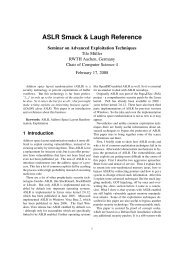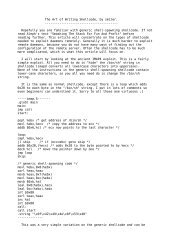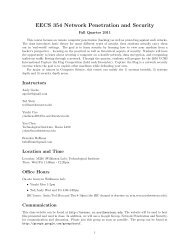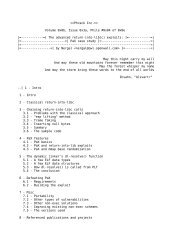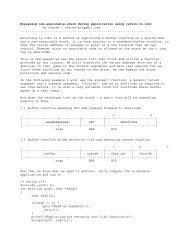Fixing Races for Fun and Profit: How to abuse atime - University of ...
Fixing Races for Fun and Profit: How to abuse atime - University of ...
Fixing Races for Fun and Profit: How to abuse atime - University of ...
You also want an ePaper? Increase the reach of your titles
YUMPU automatically turns print PDFs into web optimized ePapers that Google loves.
Attacker<br />
void main (int argc, char **argv)<br />
{<br />
// Assumes direc<strong>to</strong>ries <strong>and</strong> links:<br />
// dir0/lnk -> public file<br />
// dir1/lnk -> /etc/shadow<br />
// activedir -> dir0<br />
}<br />
// Let the victim run<br />
if (<strong>for</strong>k() == 0) {<br />
system("victim activedir/lnk");<br />
exit(0);<br />
}<br />
usleep(1); // yield CPU<br />
// Switch where target points<br />
unlink("activedir");<br />
symlink("dir1", "activedir");<br />
Figure 2: A program <strong>for</strong> exploiting access(2)/open(2)<br />
races. A non-root attacker can use this program <strong>to</strong> exploit<br />
the setuid-root program shown in Figure 1.<br />
3 The k-Race proposal<br />
Dean <strong>and</strong> Hu noticed that, in practice, exploiting the access(2)<br />
race condition can be quite difficult. Their experiments<br />
showed that a naive attacker can only expect <strong>to</strong><br />
win a race with probability 10 −3 on uniprocessor machines<br />
<strong>and</strong> 10 −1 on multiprocessor machines. Based<br />
on this evidence, Dean <strong>and</strong> Hu proposed a probabilistic<br />
countermeasure <strong>to</strong> this race condition. By requiring the<br />
attacker <strong>to</strong> win a large number <strong>of</strong> races, they intended <strong>to</strong><br />
make it practically impossible <strong>to</strong> successfully exploit the<br />
access(2)/open(2) race.<br />
An implementation <strong>of</strong> their defense is given in Figure<br />
3. The k-Race algorithm essentially repeats the access(2)/open(2)<br />
idiom k times. To ensure that the attacker<br />
must win a race between every system call, the k-<br />
Race algorithm uses fstat(2) <strong>to</strong> check that every open(2)<br />
call resolves <strong>to</strong> the same file. To see how this works, consider<br />
an attacker trying <strong>to</strong> defeat k-Race. After the victim<br />
makes the first access(2) call, the attacker must switch<br />
symlinks so that, when the victim calls open(2), the given<br />
filename points <strong>to</strong> a protected file. After the first call <strong>to</strong><br />
open(2), the attacker has tricked the victim in<strong>to</strong> opening<br />
a secret file, but the k-Race algorithm <strong>for</strong>ces the attacker<br />
<strong>to</strong> continue racing with the victim as follows. The victim<br />
next per<strong>for</strong>ms another call <strong>to</strong> access(2). The attacker<br />
must race <strong>to</strong> switch the symlink <strong>to</strong> point <strong>to</strong> a public file,<br />
or this access(2) call will not succeed. Next, the victim<br />
calls open(2) again <strong>and</strong> uses fstat(2) <strong>to</strong> verify that the re-<br />
int dh_access_open(char *fname)<br />
{<br />
int fd, rept_fd;<br />
int orig_ino, orig_dev;<br />
struct stat buffer;<br />
if (access(fname, R_OK) != 0)<br />
return -1;<br />
fd = open(fname, O_RDONLY);<br />
if (fd < 0)<br />
return -1;<br />
// This is the strengthening.<br />
// *First, get the original inode.<br />
if (fstat(fd, &buffer) != 0)<br />
go<strong>to</strong> error;<br />
orig_inode = buffer.st_ino;<br />
orig_device = buffer.st_dev;<br />
// Now, repeat the race.<br />
// File must be the same each time.<br />
<strong>for</strong> (i=0; i < k; i++) {<br />
if (access(fname, R_OK) != 0)<br />
go<strong>to</strong> error;<br />
rept_fd = open(fname, O_RDONLY);<br />
if (rept_fd < 0)<br />
go<strong>to</strong> error;<br />
}<br />
if (fstat(rept_fd, &buffer) != 0)<br />
go<strong>to</strong> error;<br />
if (close(rept_fd) != 0)<br />
go<strong>to</strong> error;<br />
if (orig_inode != buffer.st_ino)<br />
go<strong>to</strong> error;<br />
if (orig_device != buffer.st_dev)<br />
go<strong>to</strong> error;<br />
/* If generation numbers are<br />
available, do a similar check<br />
<strong>for</strong> buffer.st_gen. */<br />
return fd;<br />
error:<br />
close(fd);<br />
close(rept_fd);<br />
return -1;<br />
}<br />
Figure 3: Dean <strong>and</strong> Hu’s k-Race algorithm [4]. An attacker<br />
must win 2k + 1 races <strong>to</strong> defeat this algorithm.






